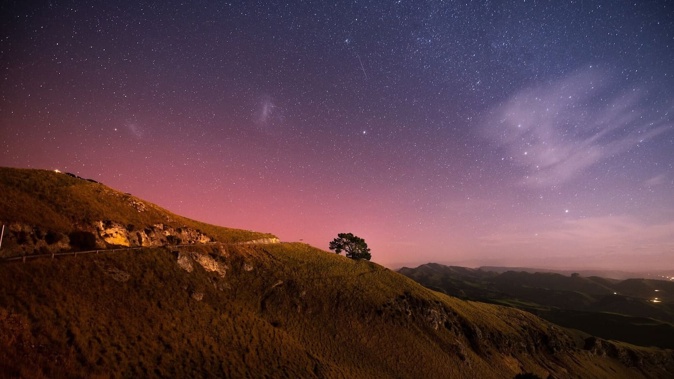
- The Aurora Australis dazzled in Aotearoa’s skies with orange, red and purple hues on the first day of winter.
- Locals in Hawke’s Bay, including Sajith Muraleedharan and Jacque Cornish, captured the display using cameras.
- The phenomenon, caused by a geomagnetic storm, was visible when the KP index reached seven.
The first official day of winter brought a dazzling surprise for sky watchers across Aotearoa, as the Aurora Australis painted the night skies with bursts of orange, red and purple hues.
In Hawke’s Bay, from Te Mata Peak to Puketitiri, in the late hours of Sunday and the early morning King’s Birthday Monday, the display kept locals awake as the southern lights danced overhead.
Sajith Muraleedharan went to Te Mata Peak to catch the show from his favourite viewing spot.
“Due to light pollution, it wasn’t clearly visible with naked eyes by 8 or 9pm.”
He told Hawke’s Bay Today he used his professional camera to capture the perfect shot just after midnight.
“The activity was high up to 7/9 [KP index]. That is when we can see here in North Island,” Muraleedharan said.
The phenomenon is caused by a geomagnetic storm triggered by solar activity, measured on a scale known as the KP index.
When this index reaches levels of 6 or higher, the Aurora Australis can be seen in Hawke’s Bay.
Taradale’s Jacque Cornish spotted the glow at 7.45pm on the Puketitiri Rd, past Rissington.
“Just the most beautiful display,” she said.
She told Hawke’s Bay Today her first experience capturing the aurora was in October last year, and she’s been chasing the lights ever since.
“This weekend I was in Taupō with my husband for a romantic getaway, we saw the signs and decided to come home early.”
The quiet weekend turned into an “exciting quest to find the best spot with the least light pollution,” she said.
“We were not disappointed as the dim pink rays unfolded into this beautiful display of the sun’s power.
“I’m transformed into an excited child completely in awe – a little cold but very happy.”
 A glimpse of the dancing southern lights from the Puketitiri Rd, captured by Jacque Cornish at 7.45pm on June 1.
A glimpse of the dancing southern lights from the Puketitiri Rd, captured by Jacque Cornish at 7.45pm on June 1.
In Havelock North, Lidiane Fernandes was at home with her family when she got a message from a friend saying the lady was dancing in the sky.
“We immediately stopped what we were doing and went outside to see this incredible phenomenon,” Fernandes told Hawke’s Bay Today.
“It was such a beautiful gift to celebrate the first day of winter.”
 Aurora Australis captured by Lidiane Fernandes from Havelock North at 10.30pm on June 1.
Aurora Australis captured by Lidiane Fernandes from Havelock North at 10.30pm on June 1.
Also, in Havelock North, Renee Altham spotted the aurora from her lawn on the hills.
“It’s such an amazing experience to see the aurora. Last night you could see it faintly with the naked eye,” she said.
“This is my third time seeing the aurora in Hawke’s Bay just in the last year. Prior to May 2024 I had never seen an aurora before but had always wanted to.”
Altham said that although it was beautiful, this show didn’t match the vivid display she captured in May last year.
 The Aurora Australis as seen from Havelock North, captured by Renee Altham from her lawn on the hills on June 1.
The Aurora Australis as seen from Havelock North, captured by Renee Altham from her lawn on the hills on June 1.
Tips for Aurora Australis hunters:
- Check solar activity forecasts through websites, apps and Facebook pages. A reading of KP6 or higher often means the aurora could be visible from Hawke’s Bay.
- Find dark skies: head away from city lights. High ground such as Te Mata Peak or the coast can offer better views.
- Be patient: auroras can appear faint to the naked eye but often show up much brighter in long-exposure photos.
- For the best shots, keep your camera steady and use night mode or manual settings.
Take your Radio, Podcasts and Music with you









